The barbell overhead tricep extension is a popular mass-building exercise for the triceps in general and the long head of the triceps in particular. This is because the long head is bigger than the lateral and medial heads combined, meaning that it’s an incredibly important muscle for developing overall arm mass.
As such, the overhead barbell tricep extension is a top choice because it works the long head excellently by placing it under an intense, muscle growth-stimulating eccentric stretch.
This in-depth guide shows you how to do 6 different types of barbell tricep extensions and then explores the benefits and drawbacks of the overhead barbell extension.
Related: Barbell tricep exercises
Overhead barbell extension exercise details
- Also Known As: Overhead BB tricep extension, straight bar overhead extension
- Main Muscles: Triceps
- Exercise Type: Strength
- Exercise Mechanics: Isolation
- Difficulty Level: Beginner
- Equipment Needed: Barbell, weights, bench
How to do standing barbell triceps extensions
- Load some weight onto a straight bar or use a preloaded barbell for more convenience.
- Grab the bar with a close overhand grip, and then stand up straight with your neck and back aligned.
- Press the bar over your head, and then tuck your elbows in.
- Lower the weight behind your head by bending your elbows.
- Descend until you feel an intense stretch in the backs of your arms (likely when your forearms touch your biceps at the bottom of the rep).
- Reverse the motion by flexing your triceps until your elbows are completely extended.
Barbell extension variations
In addition to standing barbell extensions, there are 5 main types of barbell tricep extensions that you can perform. This section discusses the pros and cons of each variation so that you can learn which exercises are best for your training goals.
Seated barbell extensions

The seated barbell extension offers excellent triceps isolation and is the top choice for bodybuilders and weight lifters seeking to maximize their muscle hypertrophy.
With the seated tricep bar extension, you don’t need to put as much effort into stabilizing your core because your torso is braced against the backrest of the bench. This is especially beneficial if your abs and co are already fatigued from your heavy compounds lifts earlier on in the workout.
Not having to brace your abs as hard means that you can better focus on training your triceps, which, after all, is the whole point of an overhead barbell triceps extension.
Yet, depending on your point of view, the reduced core stability requirement can also be a negative.
Some people like to work their core at every opportunity. And, when you lift heavy enough, the standing barbell triceps extension really does give your abs a great isometric workout because your abs have to forcefully contract in order to keep your torso straight.
The standing overhead barbell triceps extension also burns more calories than the seated version on a per-set basis because your legs and core muscles are way more active when you’re stood up.
Ultimately, the best variation for you comes down to your training goals. For maximum triceps isolation, go with the seated variation. But for more convenience (you don’t need a bench) and a broader muscular stimulus, stick with the standing barbell extension because it works more muscles.
Lying barbell extension

The lying barbell extension is one of the most popular exercises for building the triceps because it doesn’t require any fancy equipment to perform.
Due to the lying position, the exercise is also useful if the overhead tricep extension hurts your shoulders because your shoulders are naturally in a lower degree of flexion when you’re lying down, which puts less stress on your rotator cuffs.
To get the most from any kind of lying extension, however, you should bring the bar behind your head (i.e., don’t lower it to your face) as this lifting motion places the long head of the triceps under a greater eccentric stretch, which in turn leads to a more substantial hypertrophic stimulus.
The only downside is that the lying barbell extension requires a bench, whereas the standing triceps bar extension doesn’t. So if you’re training at home and don’t have access to a bench, then standing barbell triceps extensions are your best bet for building muscle.
Incline barbell tricep extensions

The straight bar incline tricep extension is a cross between a lying extension and the barbell overhead extension. Incline extensions are an exercise that really primes the triceps for growth thanks to the intense eccentric stretch that the movement naturally provides.
The incline barbell extension is an ideal exercise if you struggle to get your shoulders over your head during the standing barbell triceps extension because it doesn’t demand as much shoulder flexion. This means that your rotator cuffs won’t be under as much pressure.
Despite being an isolation exercise, incline extensions are best performed with a spotter, especially if you plan on training to muscular failure.
This is because you can actually get stuck with the bar in a compromising position if you fail at the bottom of the rep. You could, of course, just drop the bar to get yourself out of trouble, but if other people are working out around you, then dropping the barbell isn’t a safe solution. You’re much better off having a spotter handy so that they can take the bar off you if you reach muscular failure.
Decline barbell extension
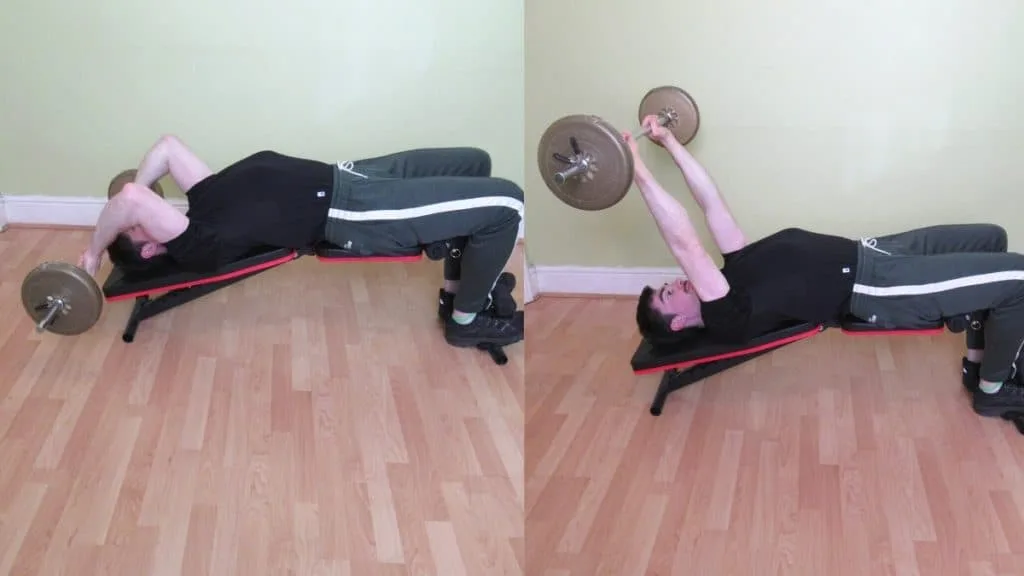
Decline barbell extensions are an effective mass-building exercise because, thanks to the sloping angle of the bench, your triceps get placed under a greater pre-stretch, which naturally takes some of the tension off your elbows.
In other words, because you’re on a decline, the force of the weight is going back as well down, which means that your shoulders (or, more specifically, one of your shoulder flexors—the long head of the triceps) take more of the strain, which in turn takes the pressure off your elbows.
Thanks to their joint-friendly disposition, decline barbell extensions are a helpful exercise for those who’ve had elbow pain after a tricep workout in the past.
This is a double-whammy because the long head, due to its prominence, is the most important triceps head for gaining mass.
Reverse grip barbell triceps extension

Performing reverse grip overhead triceps extensions encourages some lifters to keep their elbows tucked in, which in turn takes the pressure off their joints.
The problem is that using a reverse grip (which is to say a supinated grip) for the tricep barbell extension often makes it harder to hold the bar. If you lack a firm grip on the barbell, then you can’t lift as heavy, which ultimately means that your triceps are left understimulated.
Furthermore, using a reverse grip for straight bar tricep extensions doesn’t guarantee that your elbows will remain tucked. After all, with the exception of the long head, which acts on the shoulder as well, the triceps act only on the elbow. As such, changing your hand position doesn’t force your elbows to move.
In other words, using a reverse grip, while it might encourage you to minimize your elbow flare, isn’t a substitute for learning the proper lifting technique.
Some elbow flare, of course, is to be expected. You just don’t want your elbows to be pointing straight out to the sides, that’s all.
Kneeling barbell extension

The kneeling straight bar tricep extension is a great exercise for those who want to tax their triceps while challenging their core.
Although this functional movement requires more abdominal exertion than the other barbell overhead extensions, your core strength is unlikely to be the limiting factor if you stick to high reps (15-20).
Of course, if you perform lower reps with a heavy weight, then you may well end up working your abs at the expense of your triceps.
Overhead barbell tricep extension benefits
Performing an overhead tricep extension barbell style has some undeniable benefits, some of which you probably haven’t considered.
Big, strong triceps

Overhead bar extensions are obviously an excellent exercise for working the triceps.
Yet, most people don’t realize just how effective the overhead barbell extension is for building mass or, for that matter, how vital the triceps are for gaining upper arm size.
The long (inner) head of the triceps isn’t just bigger than the lateral and medial heads when compared on a head-to-head basis (pun unintended); it’s bigger than those two heads combined.
Knowing that the triceps as a whole account for around two-thirds of your upper arm size, you begin to see just how critical having good long head development is for making your arms bigger.
Nothing creates a powerful pair of triceps and tight t-shirt sleeves like a well-developed long head.
The best way to work this crucial muscle is with overhead exercises like the barbell tricep extension. These movements place the long head under an unrivaled eccentric stretch, which in turns primes your triceps for hypertrophy.
The reason that putting your shoulders into flexion (which is to say bringing your arms above your head) works so well is because only the long head crosses the shoulder joint. So when you put your shoulders in either maximum flexion or extension, the long head, as opposed to the lateral and medial heads, does the majority of the lifting.
Powerful pressing strength

If you’ve ever done any kind of compound press, whether that be a bench press or overhead press, then you undoubtedly understand the importance of having good lockout strength.
Having a powerful press lockout can mean the difference between setting new bench press PRs and lifting the same weight for months on end.
The triceps, more so than the pectorals and anterior deltoids, are the muscles most responsible for locking out heavy barbells. So if you want to press heavy weights for powerlifting, or if you simply want to overload your muscles with maximum resistance for hypertrophy, then there are no two ways about it; you need to strengthen your triceps.
If you think about it, the straight bar tricep extension is essentially a weighted tricep lockout.
Lockout is another way of saying elbow extension, which is precisely the function that you’re training during a straight bar overhead extension.
So while bench press-specific training certainly has its place, nothing will boost your pressing strength like having more triceps mass. As we’ve established, the straight bar overhead tricep extension is one of the best exercises for gaining more mass.
More upper arm mass
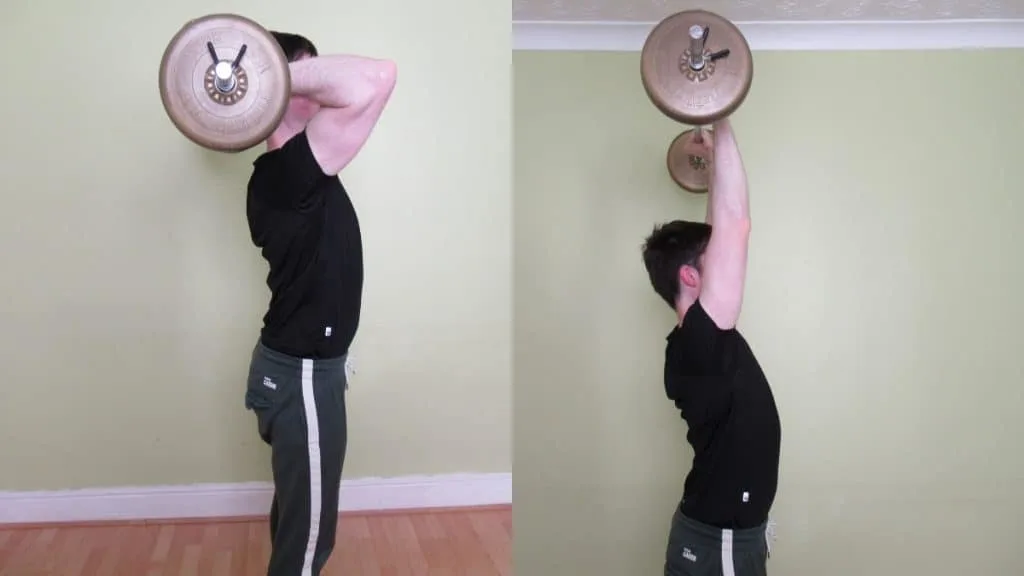
As explained, standing barbell triceps extensions are highly effective for building the triceps muscle, which in turn is a crucial area to develop when it comes to gaining arm size.
But building your upper arms with the barbell triceps extension can have some significant knock-on effects.
Building more upper arm size can help your physique to look more proportional, especially if you already have good chest development from years of bench pressing.
Having more even upper body development will ultimately lead to a more aesthetic physique, an attribute that’s particularly important if you’re a bodybuilder.
Shorter workouts

The standing overhead barbell triceps extension is a highly convenient exercise that you can perform regardless of whether you train at home or in the gym.
All you need is a half-decent barbell and a few weights; you don’t even need a bench.
As such, you don’t need to spend as much time setting up for the exercise. Nor do you need to wait around for a bench to become available.
In fact, if your routine is primarily free-weight based, then you can save yet more time by using the same barbell for the entire workout, which means that you don’t have to hop between machines (a task that’s very difficult during peak gym times).
Ultimately, sticking with simple equipment usually leads to shorter workouts. While you might only save 10 minutes per session, this time really starts to stack up over the course of the week and can prevent your workouts from dragging and becoming boring, which in turn helps you to stay motivated.
Overhead barbell tricep extension drawbacks
Despite its undeniable mass-building prowess, the standing barbell triceps extension isn’t the right exercise for everyone, especially if you have poor connective tissue health.
May hurt your wrists

Performing a standing tricep extension with a barbell can put a lot of pressure on your wrists because it forces your hands into extreme amounts of pronation.
If you’re new to resistance training and aren’t yet lifting significant amounts of weight, then there’s a good chance that you’ll be able to perform the tricep bar extension pain-free.
However, as you become stronger, your wrists, which are a tiny joint, will be forced to handle more tension.
Muscle tissue can take a beating. But joints, tendons, and ligaments all take longer to recover and get injured much more easily.
Therefore, if straight bar tricep extensions hurt your wrists, then you might want to perform a seated tricep extension with a cambered bar instead. Cambered bars, more commonly knows as EZ bars, have semi-pronated grips that are more comfortable to hold than those of straight bars.
Could hurt your elbows

Any kind of barbell tricep extension puts a lot of torque through your elbow joints because tricep extensions are a pure elbow extension exercise.
Lifting a lighter weight for more repetitions can often reduce the discomfort or even eliminate it completely because lower resistance levels reduce the torque going through your joints.
Warming up with a very light barbell and then progressively increasing the resistance before lifting your working weight can also help to prevent elbow pain.
Still, some people simply have worse joint health than others. So if you can’t perform the barbell overhead extension without it hurting your elbows, then you should give joint-friendlier alternatives a try, such as tricep pushdowns and kickbacks.
Requires good shoulder mobility
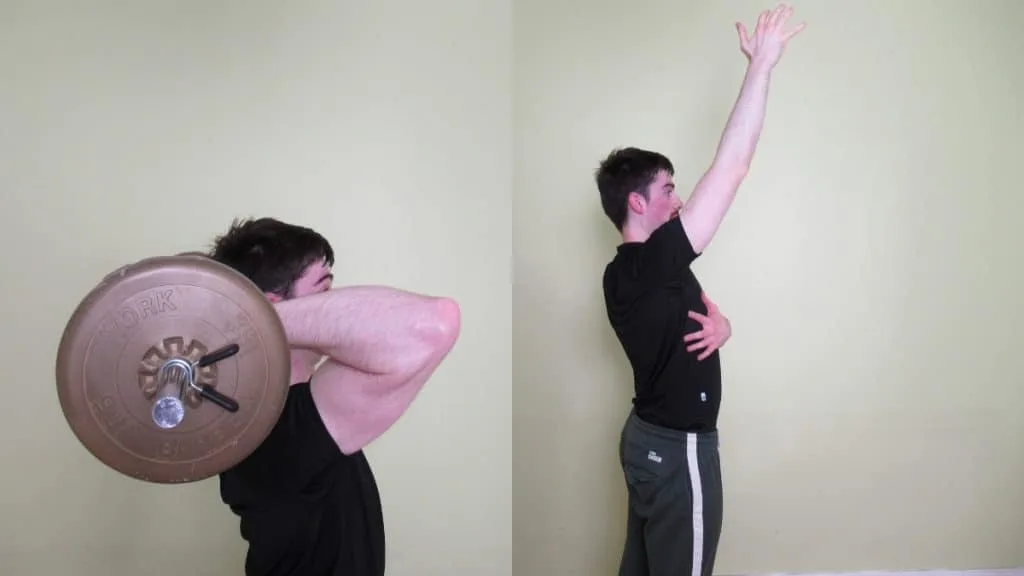
In order to be effective, which is to say, in order to place your triceps under a proper eccentric stretch, the overhead barbell extension requires good shoulder mobility. This is because you have to put your shoulders into maximum flexion to recruit the long head of the triceps optimally.
Some people just can’t get their arms all the way over their head without their rotator cuffs hurting.
If this is you, then lying tricep exercises are the solution because they work the triceps just as well but require less shoulder mobility.
When it comes to the overhead straight bar tricep extension, though, you know that your shoulders are in the correct position when your elbows are parallel with the ground.
Straight bar tricep extension sets, reps, and training frequency
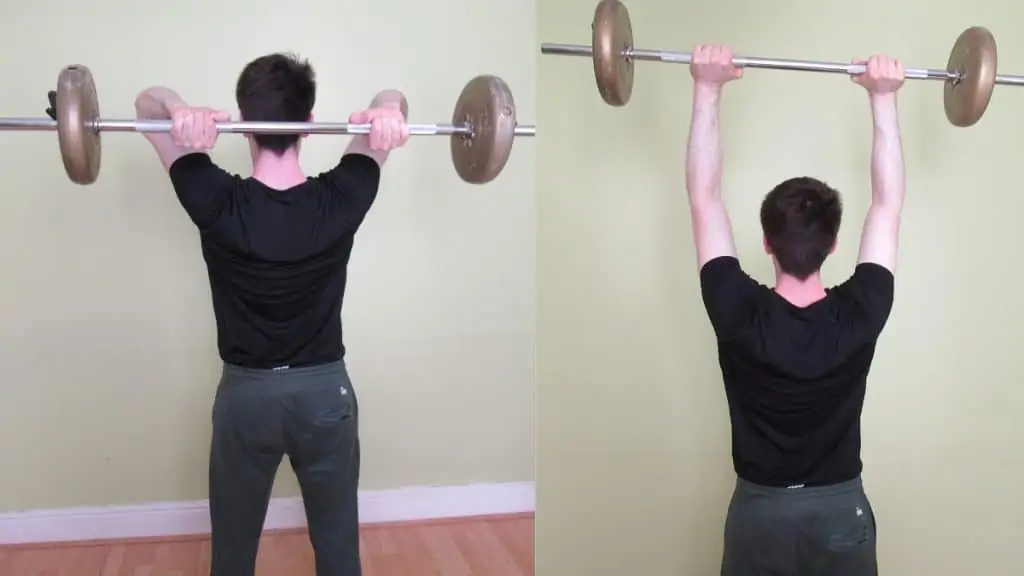
Most lifters get excellent gains in triceps size and strength by doing 3-6 sets of 8-15 reps of standing barbell extensions per session.
Since the triceps have a high proportion of type 2 (fast-twitch) muscle fibers, lifting heavy weights for low repetitions is indeed effective for stimulating triceps hypertrophy.
Yet, most people’s joints simply cannot keep up with the strength of their triceps. As such, it’s best to reserve the really heavy lifting for your compound presses, where your shoulders can take some of the strain.
Lifting lighter weights for higher reps is a great way to spare your joints while priming your triceps for growth. The only downside of high rep tricep training is that it makes you very fatigued, which may reduce the quality of your subsequent sets.
This is why moderate reps (8-15) are most recommended—they have the ideal balance between the heavy, fiber-tearing tension of low reps and the joint-sparing resistance of high reps.
Most lifters should perform the straight bar tricep extension 1-2 times per week. If you’re performing very high reps (20+), then you may be able to do the exercise more frequently.
However, considering that overhead barbell extensions place a lot of torque on the elbows and considering that joints typically take longer to recover than muscles, you should limit the frequency of overhead movements to twice-weekly in the majority of cases.
Conclusion: Should you include barbell tricep extensions in your workout routine?
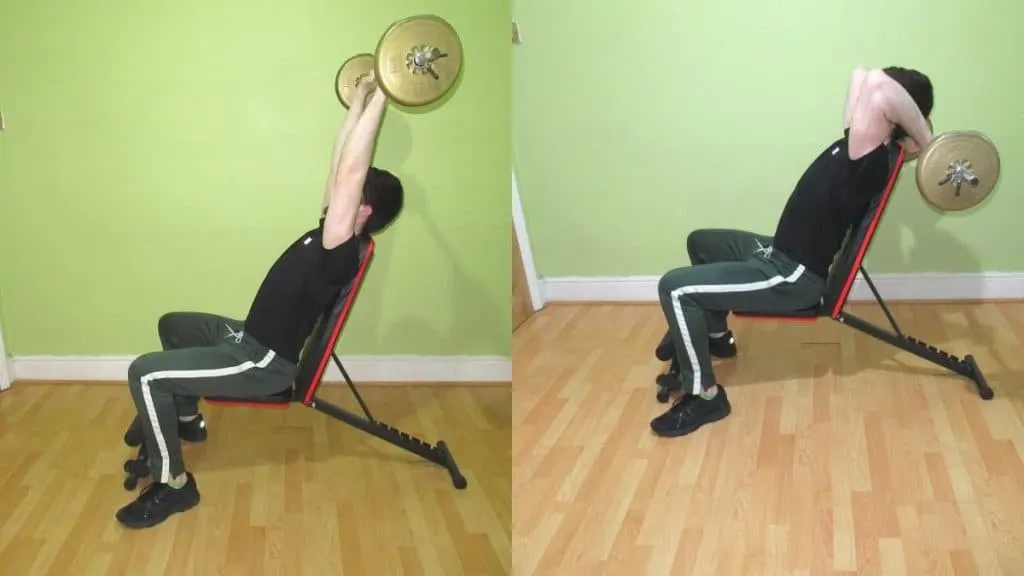
If you want to make your triceps bigger and stronger without relying on specific machines to do the job, then the overhead barbell extension is a great exercise to include in your workout routine because it requires only basic equipment.
Unlike dumbbell-based movements such as the kneeling DB tricep extension, barbell tricep extensions are naturally conducive to progressive overload and strength gain because you can increase the resistance in very manageable increments (especially if you have fractional plates).
Besides increasing the strength and size of your triceps, regularly increasing the resistance helps you to stay motivated because you’re always leveling up and watching your hard work pay off.
Since barbell extensions enable you to overload your triceps with plenty of weight, it’s best to perform standing barbell triceps extensions earlier on in your workout (definitely before pushdowns) so that you can take advantage of the exercise’s high overloading potential.

